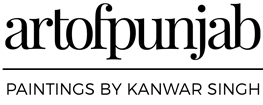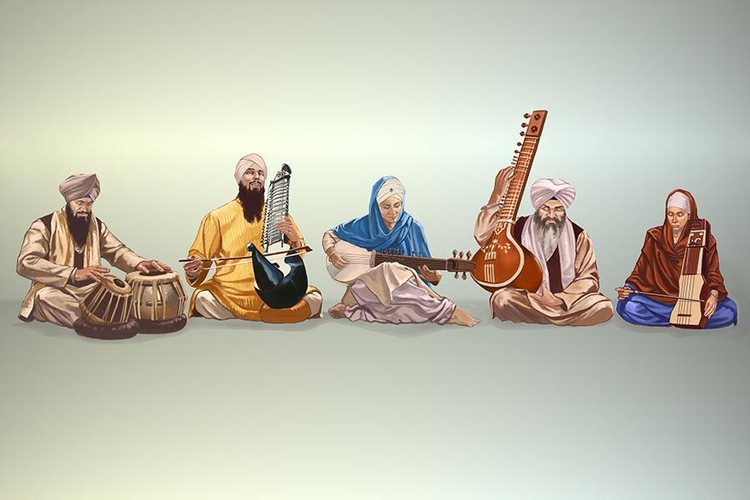-
First Guru 1469 - 1539

Guru Nanak at Kartarpur
This painting of Guru Nanak at Kartarpur is an artistic attempt to express the divine light manifested by Guru ji in his old age when he attracted many followers to sit alongside him in the wheat fields of Kartarpur. Looking at this art piece, we dwell upon the last days of Guru ji on this earth as he planted the core tenants of Sikhism in the hearts of a community of the faithful who gathered about him. He casts a royal blue shadow, which takes the shape of a warrior wearing a Dastaar and Kalgi. This foreshadows the transformation of their jyot into Guru Gobind Singh ji who would create the Khalsa panth, born out of the soil of Punjab from the seeds Guru Nanak planted generations before. To the left of Guru Nanak, we see the field of golden wheat but to the right it subtly transforms into a landscape of arrows and fire. This is an analogy for the turbulent and transformative times ahead for the land of Punjab, hardships which would engender the spiritual and bodily transformation of the Sikh community into the Khalsa panth. The tree is a metaphor for this community; it grew from the body of the Gurus into five powerful trunks (the panj pyare) and then beyond into countless more spirit born souls, stretching into the eternity of boundless time and the infinite cosmos. -
Adi Granth 1604

Guru Arjan Dev Ji - Birth of the Adi Granth
Guru Arjan Dev Ji, the fifth in the line of Guru Nanak, began the compilation of the Guru Granth Sahib, which he called the Adi Granth – the “primal knot” which would forever secure the sanctity of the Sikh faith. The Guru sent out a call to all Sikhs far and wide to bring forth the poetry composed by the four Gurus. When all the volumes had been collected, he sat down with his scribe Bhai Gurdas and carefully selected the genuine works into the Holy Granth. With the completion of this momentous work, the Guru gave the world a gift so pure and essential, that it could transcend the boundaries of time and religion and exist beyond personality and human form. -
Vaisakhi 1699
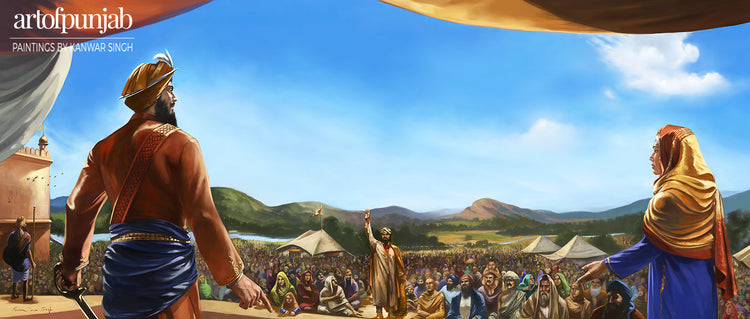
Vaisakhi 1699 Birth of the Khalsa
Bhai Daya Ram of Lahore, Punjab, is the first to raise his hand when Guru Gobind Rai asks for a volunteer willing to give his life in service of humanity. Mata Sahib Kaur looks on at the crowd of thousands that has gathered from across the land in response to the Gurus call. Transformed through Amrit into Daya Singh, he became one of the first 5 Khalsa, the Punj Pyaarey (the beloved five). -
Vaisakhi 1699
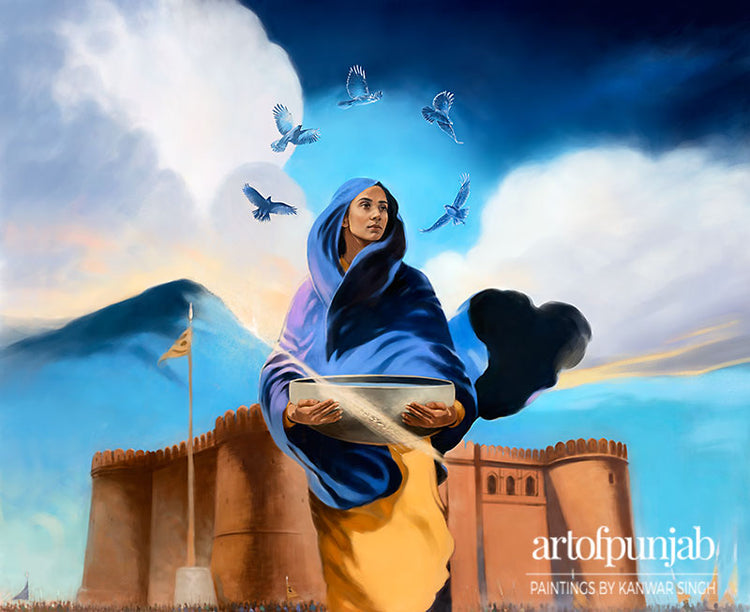
Mata Sahib Kaur - Mother of the Khalsa
Just as Guru Gobind Singh Sahib is considered the father of the Sikh nation, Mata Sahib Devan Kaur is considered its mother. A remarkable young woman, Mata Sahib Kaur was a born leader who took her role as symbolic mother of the Sikhs very seriously. When a Sikh takes Amrit from the 5 Beloved, they are born into the royal house of Nanak. To create an egalitarian society, all Sikhs consider Anandpur Sahib their birthplace and Mata Sahib Kaur their mother. -
Formation of the Khalsa 1699

Guru Gobind Singh – Master and Disciple
The first Vaisakhi (April 13, 1699) saw the initiation of the first five Khalsa. Following their investiture, Guru Gobind Rai knelt before the Five Beloved Ones and asked to be initiated in turn as the sixth ‘saint-soldier’. The Amrit ceremony marked his transformation into Gobind Singh. Thenceforth, he was hailed: “Behold the Man non-pareil! Himself the Teacher, Himself the Disciple!” -
1699

Guru Gobind Singh Maharaj
In a brilliant move of strategy and leadership, Guru Gobind Singh initiated the ceremony of Amrit and transformed the Sikhs into the fearless and united body of the Khalsa. The Khalsa became a brave and moral fighting force against the tyrannical Mughal ruler that occupied the Punjab. The Khalsa lives in the image and light of Guru Gobind Singh, dedicated to upholding righteousness, freedom, and the dignity of mankind. That is the Khalsa way. -
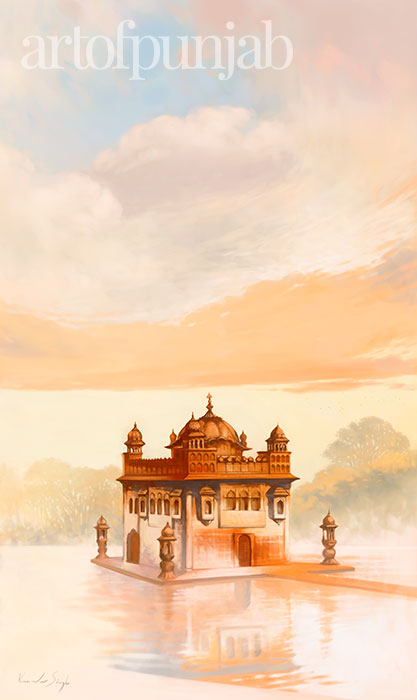
Pillar of Peace
The Harimandir Sahib is the heart of the Sikh Panth. It was conceived by Guru Ram Das ji when he built the sarovar on the site of a holy pool of water in the city of Amritsar, which he also founded. The next master, Guru Arjun completed the Harimandir sahib and installed the Adi Granth, the primal Sikh scriptures, within its walls. Harimandir sahib, in the time of the Gurus was not yet covered in gold but was already revered as the centre of Sikh spiritual life and the seat of the Gurus. Guru Hargobind would have looked across at its’ wondrous forms as he built the Akal Takhat to give Sikhs a place to settle all political and temporal affairs. Later Guru Teg Bahadur ji would sit upon the opposite edge of the sarovar and looked upon its’ four entrances with a pilgrim‘s longing when he was denied entry by the disloyal mahants. Nonetheless, the Sikh sangat of Amritsar still embraced their Guru within its’ view and today a small shrine marks that place on the sarovar in remembrance of their faith. Harimandir sahib has and will forever remain a vision of sanctity and peace within the hearts of every Sikh who lays eyes upon it. -
1665

Guru Tegh Bahadur - The Protector
Guru Tegh Bahadur the ninth in the line of Guru Nanak, laid down his life in order to protect religious freedom for all of India which was under the oppressive rule of Mughal emperor Aurunzeb, who wished to convert the entire land to Islam. According to the Guru, living a truly spiritual life meant that one should neither oppress nor allow others to be oppressed. Sikh teachings have emphasized the basic human rights of equality, justice, freedom and the right to one's own religion. Under the inspiring guidance of Guru Tegh Bahadur, the Sikhs regained their confidence and continued to grow in numbers and resources. -
1708
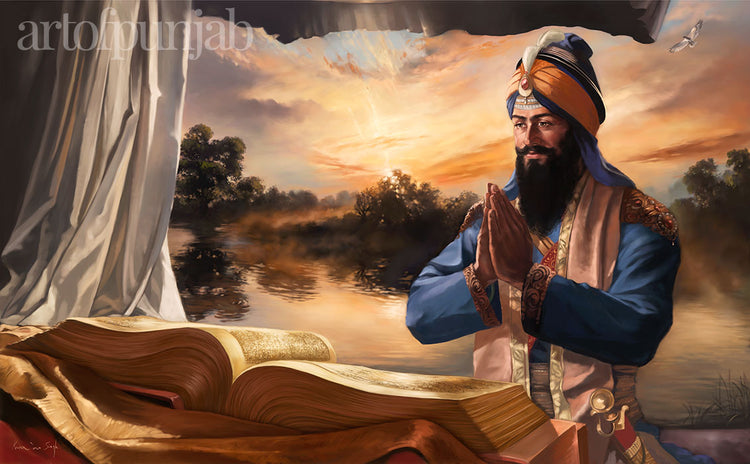
The Eternal Guru
In 1708, Guru Gobind Singh, the tenth Guru of the Sikhs, having consciously witnessed the sacrifice of the lives of all his four sons, handed over the legacy of the Guruship to the Siri Guru Granth Sahib ji, our Eternal Guru. He understood that the age of lineage was over, and so he consciously left no heirs. The unique beauty of this is that the Siri Guru Granth Sahib, our present Guru, can neither be altered nor changed in any way. It is a touchstone for all humanity that exists beyond the limitations of time and space, now and in the future. -
Sikhism 1469
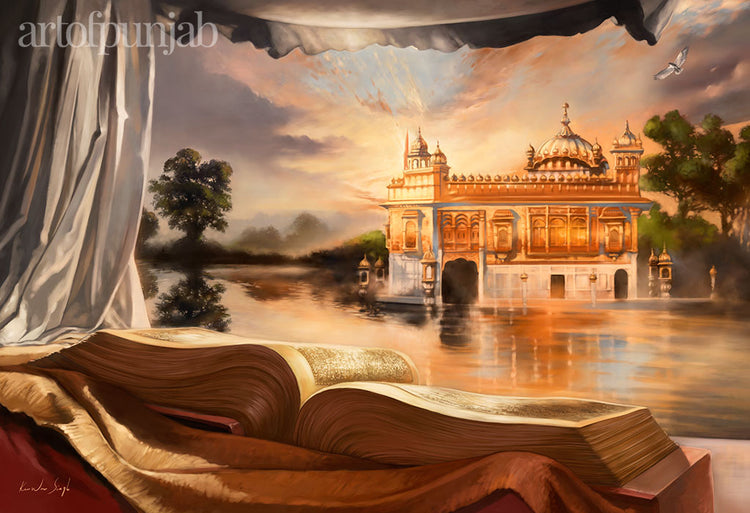
Siri Guru Granth Sahib - The Abode of Nanak
The Siri Guru Granth Sahib is the embodiment of the spiritual revolution which was first ignited by Guru Nanak dev ji and the life breath of eight more Nanaks nurtured and fed this flame. Then in 1699 Guru Gobind Singh ji, the tenth Sikh Guru, transformed that flame into a wildfire of spiritual liberation through the creation of the Khalsa panth.
We look to Siri Guru Granth Sahib as our guide to connect with the One internally, see the One in all and fight inequality and injustice in every sphere of our lives as the Gurus themselves did. The image of Harimandir Sahib (Golden Temple) reflects the other half of the spiritual revolution because it represents the innumerable gurudwaras and abodes of Nanak which we create to enable the sadh sangat to come together, remember Guru Nanak’s message and carry on his revolution.
-
18th century Punjab
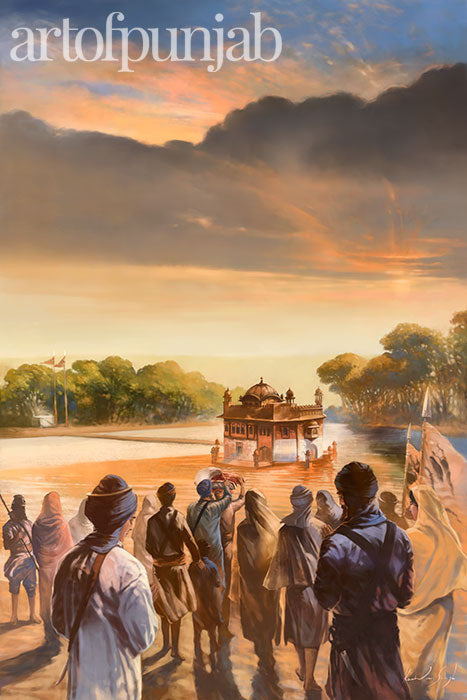
Sarbat Khalsa
During the turbulent 18th century, with the gradual collapse of the Mughal Empire and constant incursions by Afghan invaders into India, Sikhs became the de facto defenders of Punjab. During this period, Sikhs would congregate twice a year on Vaisakhi and Diwali at the Harminder Sahib. There, they would make important military and leadership decisions to help the Panth survive these difficult times. This system of collective governance allowed Sikhs to survive the tumultuous 18th century which included the greater and lesser Gulugara (Sikh Holocausts). This consensus based approach to leadership lasted throughout the Sikh Misl period and allowed them to become a collective force and the unquestioned rulers of the Punjab. The Sikhs served as the leaders and protectors of the region and through their courage and consciousness were able to lead the people through the extreme challenges of that time. -
First World War
1914 - 1918
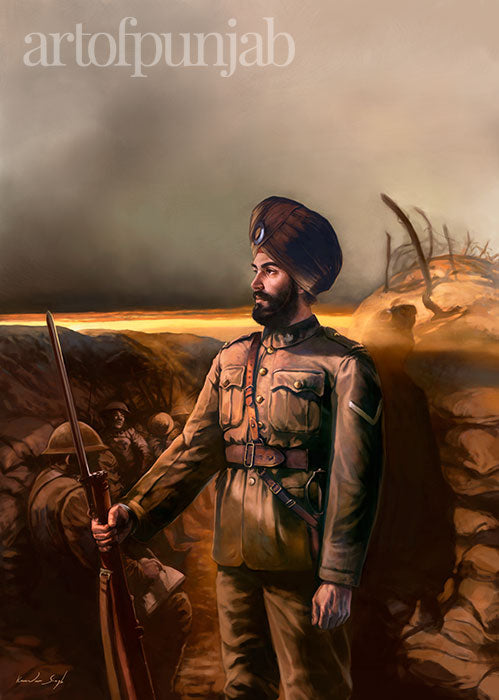
Stand on Guard for Thee
To commemorate the 100th Anniversary of Sikhs contribution to World War One, this painting represents a foray into the contemporary period of Sikh Military history. It deals with the role of Sikh men and women of various nationalities who lived through this epic confrontation of Nations. The title of the painting, taken from the Canadian National Anthem, reflects upon the willingness of Sikhs to fight against oppression throughout history. It is a testament to the spirit of Guru Gobind Singh, which forever emboldens the Khalsa to strive towards a greatness that surpasses humble beginnings. -
1995
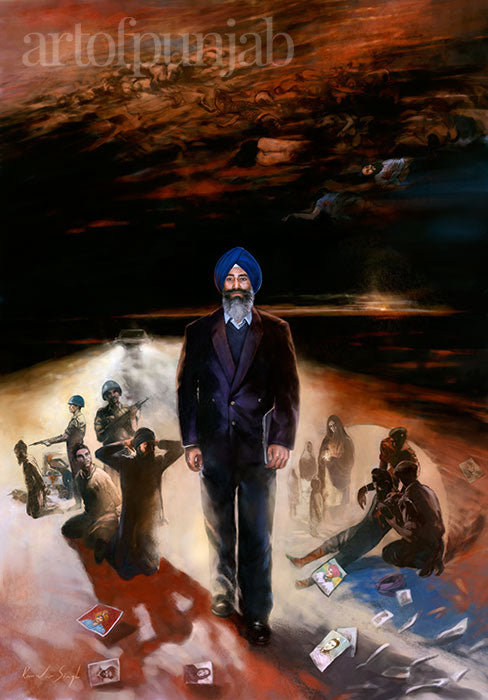
Jaswant Singh Khalra – The Witness
This painting chronicles the life's work of human rights activist Shaheed Jaswant Singh Khalra and the events of the bloody decade (1984 -1995) in Punjab. It depicts how government forces operated with complete impunity to end the Khalistan movement, and in doing so, carried out the secret murders of thousands of its' own citizens, many of them complete innocents. This portrait of Jaswant Singh Khalra and the state of Punjab speaks to the loss of humanity when power is asserted through terror and violence. In those desperate times, the Guru inspires great souls who act as our protectors, saving us from being engulfed by total darkness. In an inspirational speech, which was to be his last, Jaswant Singh Khalra declared: I challenge the darkness, if nothing else, then at least around myself, I will not let it settle. Around myself I will establish light."
Jaswant Singh Khalra was murdered at the age of 42, giving his life to the preservation of human rights in Punjab. To commemorate the incredible impact of his life, 42 rare Artist signed canvas prints will be released. All proceeds will go to Ensaaf, a charity dedicated to carrying forward his mission to end impunity and give voice to the disappeared. -
1499
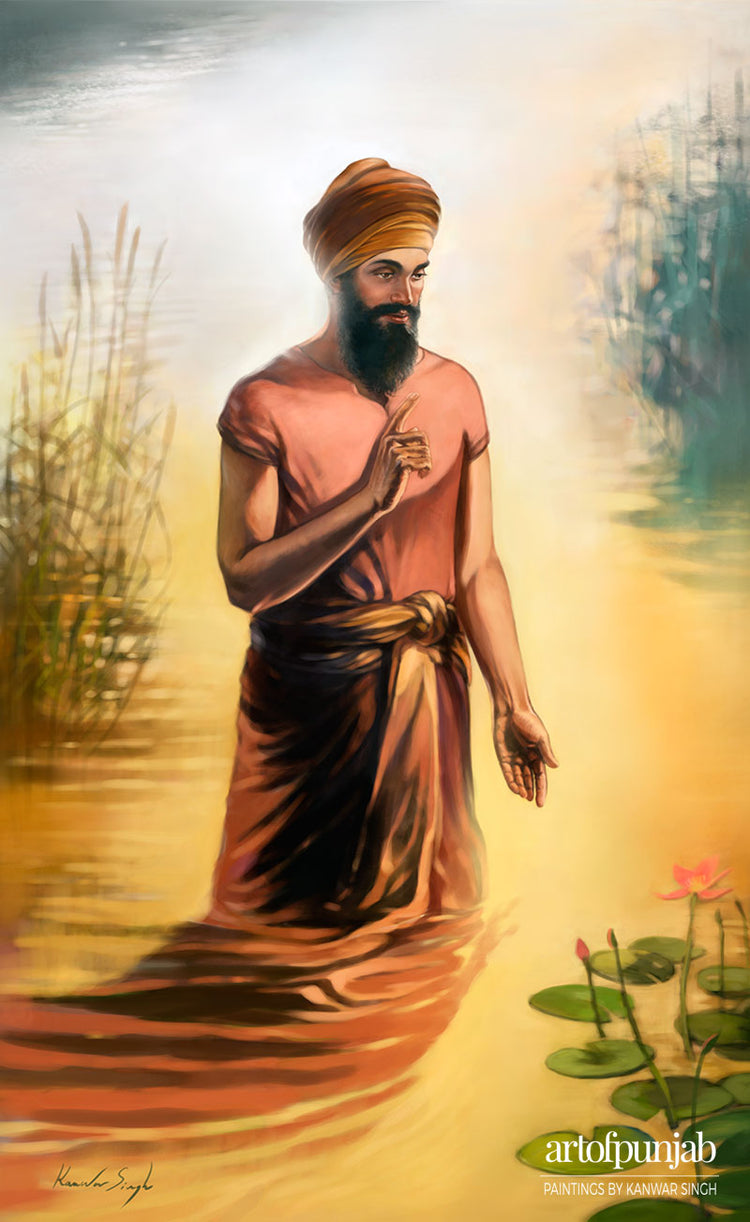
ੴ Ik Onkar
After leaving his birth village of Sabo ki Talwandi, Guru Nanak Sahib moved to Sultanpur Lodhi. It was here that one morning Guru Nanak Sahib disappeared into the dark waters of the Kali Bein rivulet. While in the water Guru Nanak had a deeply mystical experience with the Divine Creator. He was given his mission as Guru by the Divine and revealed some of the most important works of Sikh scripture including Japji Sahib, the foundational prayer of Sikhism. -
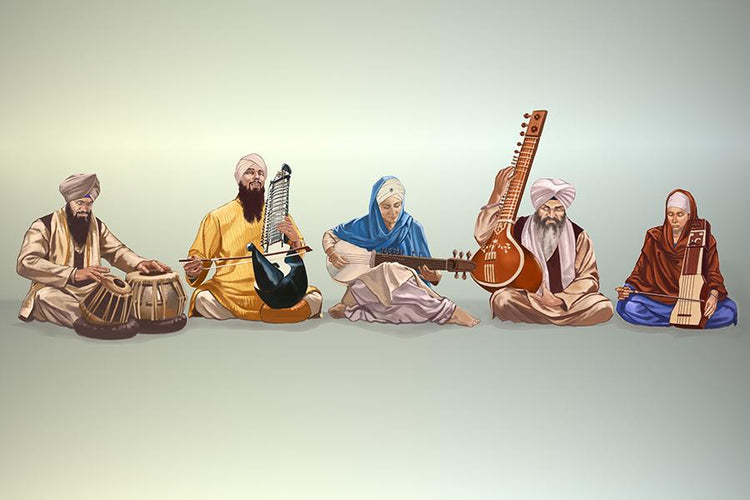
Kirtani Jatha
Kirtan is the devotional singing of praise as expressed in the hymns and compositions of Sikh scripture. Adoration expressed in song is considered by Sikhs to be the highest form of devotion, unsurpassed as the way to overcome the effect of ego and escape mortality.
